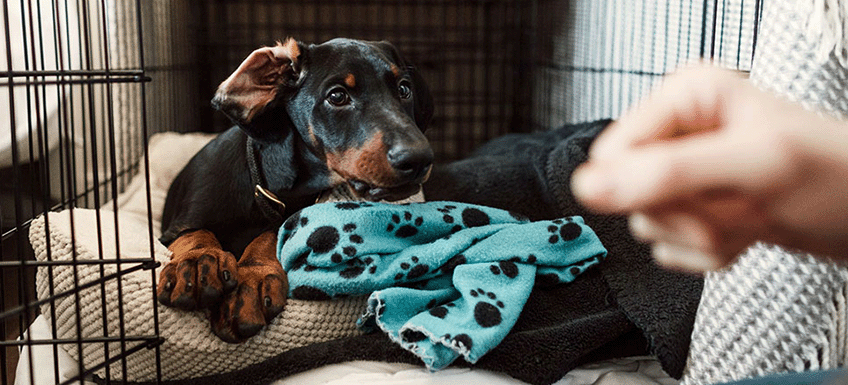
How to Crate Train Your Puppy
Puppy
Care
15/05/2023
The philosophy behind crate training a dog
Crate training uses a dog’s natural instincts as a den animal. In the wild, a dog’s den is his home, a place to sleep, hide from danger, and raise a family. The crate is designed to simulate a dog’s den, an ideal spot to sleep, take refuge from a busy household or simply relax.
The main use for a crate is house training. Dogs don’t like to go to the toilet in their dens or crate, the crate gives your dog a space that they don't want to go to the toilet in, which allows you time to put them outside to relieve themselves.
The crate also keeps your puppy safe as well as keeping your shoes and furniture safe if you are not in the house!
How to choose a crate for your puppy
Several types of crates are available from plastic, fabric to metal, at pet.co.nz we recommend a metal crate as there is no chance your puppy will chew it:
Your dog’s crate should be just large enough for them to stand up and turn around in. If your dog is still growing, choose a crate size that will accommodate their adult size. Some crates come with a divider so you can keep the area required for your puppy to the desired size and extend out the space as the puppy grows.
How to crate train your puppy
Crate training can take days or weeks, depending on your dog’s age, temperament and past experiences. It’s important to keep two things in mind while crate training:
- The crate should always be associated with something pleasant.
- Training should take place in a series of small steps. Don’t go too fast.
Step 1: Introduce your dog to the crate
Place the crate in an area of your house where the family spends a lot of time, such as the family room. Put a dry bed in the crate. Open the door and let the dog explore the crate at leisure. Some dogs will be naturally curious and start sleeping in the crate right away. If yours isn’t one of them:
- Bring them over to the crate, and talk in a happy tone of voice. Make sure the crate door is open and secured so that it won’t hit your dog and frighten them.
- Encourage your dog to enter the crate by dropping some small food treats nearby, then just inside the door, and finally, all the way inside the crate. If they refuses to go all the way in at first, that’s okay; don’t force them to enter.
- Continue tossing treats into the crate until your dog will walk calmly all the way into the crate to get the food. If they aren’t interested in treats, try tossing a favourite toy in the crate. This step may take a few minutes or as long as several days.
Step 2: Lengthen the period that they spend in the crate
After your dog is happily eating treats in the crate with no sign of fear or anxiety, you can confine them there for short time periods while you’re home.
- Call them over to the crate and give them a treat.
- Give them a command to enter, such as “bed.” Encourage them by pointing to the inside of the crate with a treat in your hand.
- After your dog enters the crate, praise, give them the treat, and close the door.
- Sit quietly near the crate for five to ten minutes, and then go into another room for a few minutes. Return, sit quietly again for a short time, and then let them out of the crate.
- Repeat this process several times a day, gradually increasing the length of time you leave them in the crate and the length of time you’re out of their sight.
- Once your dog will stay quietly in the crate for about 30 minutes with you mostly out of sight, you can begin leaving them crated when you’re gone for short time periods and/or letting them sleep there at night. This may take several days or several weeks.
Step 3. Crate your dog when you leave
After your dog can spend about 30 minutes in the crate without becoming anxious or afraid, you can begin leaving them crated for short periods when you leave the house.
- Put them in the crate using your regular command and a treat. You might also want to leave them with a few safe toys in the crate.
- Vary at what point in your “getting ready to leave” routine you put your dog in the crate. Although he shouldn’t be crated for a long time before you leave, you can crate them anywhere from five to 20 minutes prior to leaving.
- Don’t make your departures emotional and prolonged—they should be matter-of-fact. Praise your dog briefly, give them a treat for entering the crate, and then leave quietly.
When you return home, don’t reward your dog for good behaviour by responding in an excited, enthusiastic way. Keep arrivals low key to avoid increasing his anxiety over when you will return. Continue to crate your dog for short periods from time to time when you’re home so they don’t associate crating with being left alone.
How to overcome potential issues
What if my dog whines or cries in the crate?
If your dog whines or cries while in the crate at night, it may be difficult to decide whether they're whining to be let out of the crate, or whether they needs to be let outside to eliminate. If you’ve followed the training procedures outlined above, then your dog hasn’t been rewarded for whining in the past by being released from his crate. If that is the case, try to ignore the whining. If your dog is just testing you, they’ll probably stop whining soon. Yelling at them or pounding on the crate will only make things worse.
If the whining continues after you’ve ignored them for several minutes, use the phrase they associate with going outside to eliminate. If they responds and becomes excited, take them outside. This should be a trip with a purpose, not play time. If you’re convinced that your dog doesn’t need to eliminate, the best response is to ignore them until they stop whining. Don’t give in; if you do, you’ll teach your dog to whine loud and long to get what they want. If you’ve progressed gradually through the training steps and haven’t done too much too fast, you’ll be less likely to encounter this problem. If the problem becomes unmanageable, you may need to start the crate training process over again.
How to deal with puppies and separation anxiety
Attempting to use the crate as a remedy for separation anxiety won’t solve the problem. A crate may prevent your dog from being destructive, but they may injure themself in an attempt to escape from the crate. Separation anxiety problems can only be resolved with counter-conditioning and desensitisation procedures. You may want to consult a professional animal-behavior specialist for help.
Top tips to keep in mind when crate training your puppy
A crate isn’t a magical solution. If not used correctly, a dog can feel trapped and frustrated.
- Never use the crate as a punishment. Your dog will come to fear it and refuse to enter it.
- Don’t leave your dog in the crate too long. A dog that’s crated day and night doesn’t get enough exercise or human interaction and can become depressed or anxious. You may have to change your schedule, hire a pet sitter, or take your dog to a doggie daycare facility to reduce the amount of time spent in their crate every day.
- Puppies under six months of age shouldn’t stay in a crate for more than three or four hours at a time. They can’t control their bladders and bowels for that long. The same goes for adult dogs that are being housetrained. Physically, they can hold it, but they don’t know they’re supposed to.
- Crate your dog only until you can trust they won't destroy the house. After that, it should be a place they go voluntarily.
- Use a drybed for young puppies, it works like a nappy and draws away moisture. For convenience, it is worth getting two dry beds so you have a spare while one is in the wash.

Written by The Pet.co.nz
Team
Written by The Pet.co.nz Team
A team of specialists with backgrounds in animal nursing, animal care, and all things pet related.